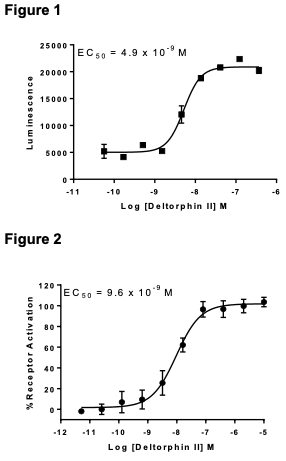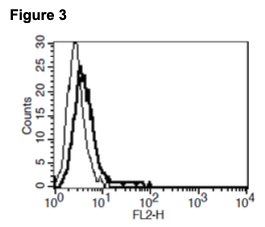Product Information
Catalog Number:
CA1351-1
Lot Number:
CA1351-1-100818
Quantity:
1 vial (2 x 106) frozen cells
Freeze Medium:
Cellbanker 2
Host cell:
CHO-K1 β-Arrestin2
Transfection:
Expression vector containing full-length human OPRD1 cDNA (GenBank Accession Number NM_000911.3) with FLAG tag sequence at N-terminus and ARRB2 cDNA (GenBank Accession Number NM_004313.3)
Recommended Storage:
Liquid nitrogen upon receiving
Propagation Medium: DMEM/F12, 10% FBS, 10 μg/mL puromycin, 800 μg/mL G418
Stability:
Stable after minimum two months continuous growth.
Data Sheet
Background: δ opioid receptor (DOR) inhibits neurotransmitter release by reducing Ca++ currents and increasing K+ conductance. In rats, morphine tolerance is associated with DOR-mediated activation of cortical CCKergic systems. There are indications that some DOR antagonists produce potent antitussive effects and may be considered as candidates of antitussive drugs. In contrast, some DOR agonists have shown antinociceptive, seizuregenic and convulsive properties, implicating a role for the DOR in depression. Early clinical experiments have demonstrated that exogenously administered opioid peptides had antidepressant activity in human patients, suggesting that the receptor may provide a new therapeutic target for treating depression.
Application: Functional assays


Figure 1. Dose-dependent stimulation from arrestin recruitment upon treatment with ligand, monitored on Flexstation III. Figure 2. Dose-dependent inhibition of forskolin- stimulated intracellular cAMP level upon treatment with ligand, measured with MultiscreenTM TR-FRET cAMP 1.0 No Wash Assay Kit (Multispan MSCM01). Figure 3. Receptor expression on cell surface measured by flow cytometry (FACS) using an anti-FLAG antibody. Thin line: parental cells; thick line: receptor-expressing cells.
References:
Becker et al. (2000) Delta-opioid receptor-mediated increase in cortical extracellular levels of cholecystokinin-like material by subchronic morphine in rats. Neuropharmacology 39:161-171.
Kamei (2002) Delta-opioid receptor antagonists as a new concept for central acting antitussive drugs. Pulm Pharmacol Ther 15:235-240.
Broom et al. (2002) Behavioral effects of delta-opioid receptor agonists: potential antidepressants? Jpn J Pharmacol 90:1-6.
